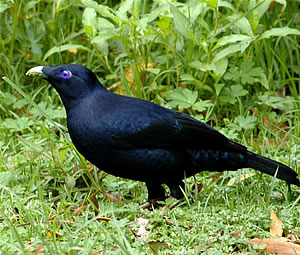Facts About Satin bowerbird
The satin bowerbird is a captivating species indigenous to eastern Australia, renowned for its distinctive behaviors and striking appearance. Adult males are particularly eye-catching with their violet-blue eyes and lustrous blue-black feathers. In contrast, females display greenish-brown or brown plumage but share the same striking blue eyes. These birds are commonly found in rainforests and tall wet forests across eastern Australia, with a significant population in the Wet Tropics of North Queensland.
Their diet primarily consists of fruits, though they also consume leaves, seeds, and insects. Remarkably, they have adapted well to new plant species introduced since European settlers arrived, contributing significantly to the propagation of these plants. However, their preference for fruit often leads to conflicts with farmers, as they sometimes raid crops.
One of the most fascinating aspects of the satin bowerbird is its courtship ritual. Male birds construct intricate structures called bowers and adorn them with colorful objects to entice females. The females then choose their mates based on the appearance of these bowers and the males' display behaviors. After a pair bonds, the female is solely responsible for nest building and incubation.
The nesting season spans from October to February. Females typically lay two eggs in nests made of twigs and camouflaged with leaves. The eggs hatch after approximately 21 days, and the chicks are ready to fledge after three weeks. Females reach maturity around two to three years of age, while males require a bit longer, maturing at seven to eight years.
Satin bowerbirds exhibit relatively long lifespans for their size, averaging eight to nine years. Some individuals have been recorded living up to 26 years in the wild, making them one of the longest-lived passerine species known from banding data.
